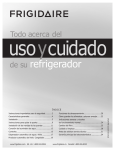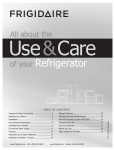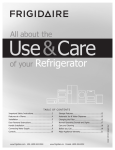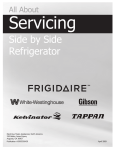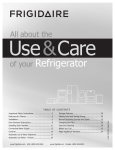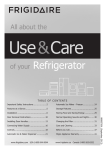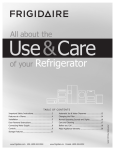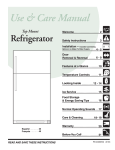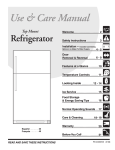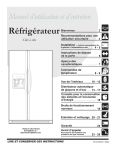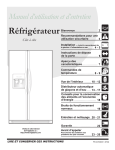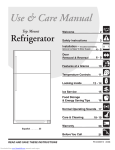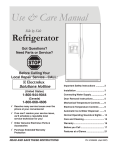Download Frigidaire FGHN2866PE Use and Care Manual
Transcript
All about the Use & Care of your Refrigerator TA B L E O F C O N T E N T S Storage Features..................................................17 Features at a Glance...............................................4 Storing Food and Saving Energy............................20 Installation............................................................5 Normal Operating Sounds and Sights.....................21 Door Removal Instructions......................................9 Changing the Filter...............................................22 Installing Door Handles.........................................11 Care and Cleaning................................................24 Connecting Water Supply......................................13 Before you Call.....................................................27 Controls...............................................................14 Major Appliance Warranty.....................................29 Automatic Ice Maker.............................................16 www.frigidaire.com USA 1-800-944-9044 www.frigidaire.ca Canada 1-800-265-8352 242292000 (October 2012) Important Safety Instructions..................................2 IMPORTANT SAFETY INSTRUCTIONS Installation Checklist WARNING Please read all instructions before using this refrigerator. For your Safety • DO NOT store or use gasoline, or other flammable liquids in the vicinity of this or any other appliance. Read product labels for warnings regarding flammability and other hazards. • DO NOT operate the refrigerator in the presence of explosive fumes. Doors Handles are secure and tight Door seals completely to cabinet on all sides Freezer drawer is level across the top Leveling Refrigerator is level, side-to-side and tilted ¼ inch (6 mm) front-to-back Toe grille is properly attached to refrigerator • Avoid contact with any moving parts of automatic ice maker. Cabinet is setting solid on all corners • Remove all staples from the carton. Staples can cause severe cuts, and also destroy finishes if they come in contact with other appliances or furniture. House power turned on Definitions This is the safety alert symbol. It is used to alert you to potential personal injury hazards. Obey all safety messages that follow this symbol to avoid possible injury or death. DANGER DANGER indicates an imminently hazardous situation which, if not avoided, will result in death or serious injury. Electrical Power Refrigerator plugged in Ice Maker (select models) House water supply connected to refrigerator No water leaks present at all connections recheck in 24 hours Ice maker is turned ON Final Checks Shipping material removed Fresh food and freezer temperatures set Crisper humidity controls set WARNING WARNING indicates a potentially hazardous situation which, if not avoided, could result in death or serious injury. CAUTION CAUTION indicates a potentially hazardous situation which, if not avoided, may result in minor or moderate injury. IMPORTANT IMPORTANT indicates installation, operation or maintenance information which is important but not hazard-related. 2 Registration card sent in IMPORTANT SAFETY INSTRUCTIONS Child Safety prong receptacle. The receptacle must be installed in accordance with local codes and ordinances. Consult a qualified electrician. Avoid connecting refrigerator to a Ground Fault Interrupter (GFI) circuit. Do not use an extension cord or adapter plug. Destroy or recycle the carton, plastic bags, and any exterior wrapping material immediately after the refrigerator is unpacked. Children should NEVER use these items to play. Cartons covered with rugs, bedspreads, plastic sheets or stretch wrap may become airtight chambers, and can quickly cause suffocation. • If the power cord is damaged, it should be replaced by an authorized service technician to prevent any risk. Proper Disposal of your Refrigerator or Freezer • Never unplug the refrigerator by pulling on the power cord. Always grip the plug firmly, and pull straight out from the receptacle to prevent damaging the power cord. Risk of child entrapment • Unplug the refrigerator before cleaning and before replacing a light bulb to avoid electrical shock. Child entrapment and suffocation are not problems of the past. Junked or abandoned refrigerators or freezers are still dangerous – even if they will sit for “just a few days”. If you are getting rid of your old refrigerator or freezer, please follow the instructions below to help prevent accidents. Proper Disposal of Refrigerators/Freezers We strongly encourage responsible appliance recycling/ disposal methods. Check with your utility company or visit www.energystar.gov/recycle for more information on recycling your old refrigerator. Before you throw away your old refrigerator/ freezer: • Remove doors. • Leave shelves in place so children may not easily climb inside. • Have refrigerant removed by a qualified service technician. • Performance may be affected if the voltage varies by 10% or more. Operating the refrigerator with insufficient power can damage the compressor. Such damage is not covered under your warranty. • Do not plug the unit into an electrical outlet controlled by a wall switch or pull cord to prevent the refrigerator from being turned off accidentally. IMPORTANT Pressing and holding the On/Off button for three seconds, located on the left side of the temperature control panel will disable your refrigerator’s cooling system, but does not disconnect the power to the light bulb and other electrical components. To turn off power to your refrigerator you must unplug the power cord from the electrical outlet. Grounding type wall receptacle Do not, under any circumstances, cut, remove, or bypass the grounding prong. IMPORTANT CFC/HCFC Disposal Your old refrigerator may have a cooling system that used CFCs or HCFCs (chlorofluorocarbons or hydrochlorofluorocarbons). CFCs and HCFCs are believed to harm stratospheric ozone if released to the atmosphere. Other refrigerants may also cause harm to the environment if released to the atmosphere. If you are throwing away your old refrigerator, make sure the refrigerant is removed for proper disposal by a qualified technician. If you intentionally release refrigerant, you may be subject to fines and imprisonment under provisions of environmental legislation. Electrical information • The refrigerator must be plugged into its own dedicated 115 Volt, 60 Hz., 15 Amp, AC only electrical outlet. The power cord of the appliance is equipped with a three-prong grounding plug for your protection against electrical shock hazards. It must be plugged directly into a properly grounded three Power cord with 3-prong grounded plug CAUTION To avoid personal injury or property damage, handle tempered glass shelves carefully. Shelves may break suddenly if nicked, scratched, or exposed to sudden temperature change. 3 FEATURES AT A GLANCE *Features may vary according to model *LED Cluster Light Flipper Guide Water Filter *LED Cluster Light Dairy Compartment Air Filter SpillSafe™ Shelf *LED Cluster Light *LED Cluster Light Slide Under Shelf Flipper Mullion *LED Cluster Light *LED Cluster Light Crisper Drawer Crisper Drawer Door Bin Deli Drawer Adjustable Hinges *Ice Maker Freezer Baskets Ice Bin Toe Grille IMPORTANT Features not included with your refrigerator can be purchased at www.frigidaire.com or by calling 1-800-944-9044. 4 INSTALLATION Required Tools You will need the following tools: Components Provided: Top Hinge Cover Front Screw Tools Necessary: Top Hinge Cover Rear Screw (OR) Top Hinge Screw Lower Hinge Screw Phillips™ Head or #2 Square Drive Head This Use & Care Guide provides general installation and operating instructions for your model. We recommend using a service or kitchen contracting professional to install your refrigerator. Use the refrigerator only as instructed in this Use & Care Guide. Before starting the refrigerator, follow these important first steps. Location • Choose a place that is near a grounded, non-GFCI, electrical outlet. Do Not use an extension cord or an adapter plug. • If possible, place the refrigerator out of direct sunlight and away from the range, dishwasher, or other heat sources. • The refrigerator must be installed on a floor that is level and strong enough to support a fully loaded refrigerator. • Consider water supply availability for models equipped with an automatic ice maker. OR OR AND Socket Wrench Set Adjustable Wrench 3/8" Fixed Wrench Installation • Allow the following clearances for ease of installation, proper air circulation, and plumbing and electrical connections: Sides & Top Back /8 inch (9.5 mm) 1 inch (25.4 mm) 3 NOTE If your refrigerator is placed with the door hinge side against a wall, you may have to allow additional space so the door can be opened wider. Door opening Your refrigerator should be positioned to allow easy access to a counter when removing food. For best use of refrigerator drawers and freezer baskets, the refrigerator should be in a position where both can be fully opened. CAUTION Do Not install the refrigerator where the temperature will drop below 55°F (13°C) or rise above 110°F (43°C). The compressor will not be able to maintain proper temperatures inside the refrigerator. Do Not block the toe grille on the lower front of your refrigerator. Sufficient air circulation is essential for the proper operation of your refrigerator. 5 INSTALLATION Leveling Freezer Drawer (if necessary) 1 Check gasket seal around top, bottom, and sides of freezer drawer. 2 If gasket is not sealed, open drawer and slightly loosen four drawer screws (two on each side) to allow drawer to rotate. 3 Close drawer and recheck the seal on the gasket (A). Open the drawer grabbing by the sides in the center (B). Be careful not to rotate the drawer. Remove Hex Head Drawer Screw Remove Hex Head Drawer Screw Do Not Remove Other Screws 1 Slightly open freezer drawer. Lift the toe grille and gently pull forward (see illustration). 2 You can raise or lower each door. Use a ⅜ inch socket wrench to turn the adjustment screws (one per side). Toe Grille Must Fit in Slot on Anti-tip Bracket Screw/Washer Assembly Do Not Remove Other Screws Remove Hex Head Drawer Screw Remove Hex Head Drawer Screw (3) Retaining Clips To raise: turn adjustment screw clockwise. To lower: turn adjustment screw counterclockwise. 4 Tighten four drawer screws. 5 Recheck gasket seal. 3 Ensure both doors are bind-free with their seals touching the cabinet on all four sides and that cabinet is stable. Grab Drawer At Center From Both Sides Then Pull Drawer Out Push Against Freezer Drawer A To level the cabinet using the front rollers (select models): B 4 After unit is leveled, lower anti-tip leg until it contacts the floor. Door Door Level Refrigerator & Adjust Doors (if necessary) Guidelines for final positioning of your refrigerator: • All four corners of the cabinet must rest firmly on the floor. • The sides should tilt ¼ inch (6 mm) from front to back (to ensure that doors close and seal properly). Raise Anti-tip Leg Lower • Doors should align with each other and be level. Most of these conditions can be met by raising or lowering the adjustable front rollers. 6 5 Install the toe grille by fitting into place. INSTALLATION To adjust the door stop: 5 Retighten screw. Door stop is adjustable between 85 to 145 degrees. NOTE Rotate Door Stop View shown is looking up at the bottom of the refrigerator door. Lower Hinge Re-tighten Screw Door Stop Retighten Screw Min Open Screw Max Open Adjustable Door Stop 1 Open door to provide access to screw. 2 Loosen screw. 3 Adjust door to desired location. 6 Ensure door stops in desired location before resuming normal use. To level the doors using the adjustable lower hinge (select models): 1 Remove all food items from door bins on door being adjusted. 2 Open doors to 90 degrees. 3 Loosen or remove screw. B A Rotate Door to Desired Location Loosen or Remove Screw Open Door 90 Degrees Bottom of Door Loosen/Remove Screw (where applicable) Adjusting Door 4 Rotate door stop until it makes contact with the lower hinge. NOTE Adjustable hinge should only be used after doors have been leveled with rollers. 7 INSTALLATION 4 Lift the door while adjusting the washer. To raise the door, rotate washer clockwise (when viewed from the bottom). To lower door, rotate washer counterclockwise (when viewed from the bottom). 2 Adjust flipper mullion height. For proper connection with the flipper mullion guide, there should be a separation about the thickness of a coin (0.060 inches, or 1.5 mm) between the guide and flipper mullion. Mullion Guide Flipper Mullion Lower Door Thickness of a Coin Raise Door Hinge Washer Raising/Lowering Door Adjusting Flipper Mullion Height 3 Retighten screw. To adjust the flipper mullion: 1 Loosen the screw located on the flipper mullion hinge. Flipper Mullion Screw Flipper Mullion Hinge Adjusting Flipper Mullion Screw 8 DOOR REMOVAL INSTRUCTIONS Getting through narrow spaces If your refrigerator will not fit through an entrance area, you can remove the doors. Check first by measuring the entrance. To remove the refrigerator doors: 1 Trace lightly around the door’s top hinges with a pencil. This makes reinstallation easier. To prepare for removing the doors: 1 Make sure the electrical power cord is unplugged from the wall outlet. 2 Open the freezer drawer and remove the toe grille (see “Installation” section). 3 Remove any food from the door shelves and close the doors. To remove the top hinge covers: 1 Remove the two screws from each cover over the top door hinges. 2 Lift inside edge of hinge cover and tilt back. Front Cover Screw Top Hinge Cover Hinge Screws Ground Screw Multi-wire Cables Top Hinge Leave Hinge With Door Rear Cover Screw Rear Cover Screw 2 Disconnect the harness by grasping both sides of the connector firmly, depress the latch, and pull apart. Remove the two screws from the top hinge. Lift the door off of the bottom hinge and set it aside. Front Cover Screw Ground Top Hinge Screw Top Hinge Cover Hinge Screws Two Wire Cables Leave Hinge With Door NOTE DO NOT remove the ground screw from hinge. 9 DOOR REMOVAL INSTRUCTIONS Installing Freezer Drawer NOTE You will be pulling approximately three feet of water tube from the back of the refrigerator. 1 With lower slides pulled out, hang drawer onto slide brackets ensuring pins on each side are fully inserted into slots on each side. 4 Unscrew the three lower hinge screws and hinge if necessary. Drawer Assembly To reinstall the right door, reverse the above steps. Fully Extend Drawer Slides Lower Hinge Removal Pin Cabinet Slot 2 Reinstall four drawer screws (two per side), tighten down, and close drawer (C). Once both doors are in place, ensure they are aligned with each other and level (Please see the “Installation” section for more details), and replace the top hinge cover. Install Screws (2) Each Side CAUTION Be sure doors are set aside in a secure position where they cannot fall and cause personal injury, or damage to the doors or handles. Removing Freezer Drawer 1 Open freezer drawer. 2 Remove drawer screws on right and left sides (two screws on each side). Remove Hex Head Drawer Screw Remove Hex Head Drawer Screw Do Not Remove Other Screws 3 Check gasket seal around top, bottom, and sides of freezer drawer. 4 If gasket is not sealed, open drawer and slightly loosen four drawer screws (two on each side) to allow drawer to rotate. 5 Close drawer and recheck the seal on the gasket (A). Open the drawer grabbing by the sides in the center (B). Be careful not to rotate the drawer. Do Not Remove Other Screws Grab Drawer At Center From Both Sides Then Pull Drawer Out Push Against Freezer Drawer Remove Hex Head Drawer Screw CAUTION Drawer is heavy. Use caution when lifting. 3 Lift drawer up and out to remove. 10 Remove Hex Head Drawer Screw A B 6 Tighten four drawer screws. 7 Recheck gasket seal. 8 Install the toe grille by fitting into place. INSTALLING DOOR HANDLES Door Handle Mounting Instructions for Frigidaire Gallery® 1 Remove handles from carton and any other protective packaging. 2 Position fresh food handle end over upper and lower pre-installed shoulder bolts (A) that are fastened into door, ensuring the holes for the set screws are facing towards the opposite door. 3 While holding handle firmly against door, fasten upper and lower Allen set screws (B) with supplied Allen wrench. 4 Repeat steps 2 and 3 to install opposite handle. Ensure the holes for the set screws are facing towards the first door. 5 Position freezer handle end over left and right pre-installed handle mounts that are fastened to the door, ensuring the holes for the set screws are facing down. 6 While holding handle firmly against door, loosely tighten far right Allen set screw (B) with supplied Allen wrench until there is no gap between handle and door. 7 Still holding the handle firmly to the door, firmly tighten far left Allen set screw (B) with supplied Allen wrench. 8 Return to the far right Allen set screw (B) and firmly tighten with supplied Allen wrench. NOTE All set screws should be tightened so the screw is below the surface of the handle. The handles should be drawn tight to freezer and refrigerator doors with no gaps. Opening the opposite door while tightening the Allen screw makes installation easier. The door handle may loosen over time or if it was installed improperly. If this happens, tighten the set screws on the handles. Mounting Refrigerator Handles Mounting Freezer Handle CAUTION Wear gloves and safety goggles. Use extreme CAUTION when installing these handles. 11 INSTALLING DOOR HANDLES Door Handle Mounting Instructions for Frigidaire Professional® 1 Remove handles from carton and any other protective packaging. 2 Position fresh food handle end over upper and lower pre-installed shoulder bolts (A) that are fastened into door, ensuring the holes for the set screws are facing towards the opposite door. 3 While holding handle firmly against door, fasten upper and lower Allen set screws (B) with supplied Allen wrench. 4 Repeat steps 2 and 3 to install opposite handle. Ensure the holes for the set screws are facing towards the first door. 5 Position freezer handle end over left and right pre-installed handle mounts that are fastened to the door, ensuring the holes for the set screws are facing down. 6 While holding handle firmly against door, loosely tighten far right Allen set screw (B) with supplied Allen wrench until there is no gap between handle and door. 7 Still holding the handle firmly to the door, firmly tighten far left Allen set screw (B) with supplied Allen wrench. 8 Return to the far right Allen set screw (B) and firmly tighten with supplied Allen wrench. 9 Firmly tighten the inside Allen set screws. NOTE All set screws should be tightened so the screw is below the surface of the handle. The handles should be drawn tight to freezer and refrigerator doors with no gaps. Opening the opposite door while tightening the Allen screw makes installation easier. The door handle may loosen over time or if it was installed improperly. If this happens, tighten the set screws on the handles. Mounting Refrigerator Handles Mounting Freezer Handle CAUTION Wear gloves and safety goggles. Use extreme CAUTION when installing these handles. 12 CONNECTING THE WATER SUPPLY WARNING To avoid electric shock, which can cause death or severe personal injury, disconnect the refrigerator from electrical power before connecting a water supply line to the refrigerator. CAUTION To Avoid Property Damage: •Copper or Stainless Steel braided tubing is recommended for the water supply line. Water supply tubing made of ¼ inch plastic is not recommended to be used. Plastic tubing greatly increases the potential for water leaks, and the manufacturer will not be responsible for any damage if plastic tubing is used for the supply line. •DO NOT install water supply tubing in areas where temperatures fall below freezing. •Chemicals from a malfunctioning softener can damage the ice maker. If the ice maker is connected to soft water, ensure that the softener is maintained and working properly. IMPORTANT Ensure that your water supply line connections comply with all local plumbing codes. Before Installing The Water Supply Line, You Will Need: • Basic Tools: adjustable wrench, flat-blade screwdriver, and PhillipsTM screwdriver • Access to a household cold water line with water pressure between 30 and 100 psi. • A water supply line made of ¼ inch (6 mm) OD, copper or stainless steel tubing. To determine the length of tubing needed, measure the distance from the ice maker inlet valve at the back of the refrigerator to your cold water pipe. Then add approximately 7 feet (2.1 meters), so the refrigerator can be moved out for cleaning (as shown). • A shutoff valve to connect the water supply line to your household water system. DO NOT use a selfpiercing type shutoff valve. • Do not reuse compression fitting or use thread seal tape. • A compression nut and ferrule (sleeve) for connecting a copper water supply line to the ice maker inlet valve. NOTE To Connect Water Supply Line To Ice Maker Inlet Valve 1. Disconnect refrigerator from electric power source. 2. Place end of water supply line into sink or bucket. Turn ON water supply and flush supply line until water is clear. Turn OFF water supply at shutoff valve. 3. Remove plastic cap from water valve inlet and discard cap. 4.If you use copper tubing - Slide brass compression nut, then ferrule (sleeve) onto water supply line. Push water supply line into water valve inlet as far as it will go (¼ inch/6 mm). Slide ferrule (sleeve) into valve inlet and finger tighten compression nut onto valve. Tighten another half turn with a wrench; DO NOT overtighten. See Figure 1. If you use stainless steel tubing - The nut and ferrule are already assembled on the tubing. Slide compression nut onto valve inlet and finger tighten compression nut onto valve. Tighten another half turn with a wrench; DO NOT overtighten. See Figure 2. 5. With steel clamp and screw, secure water supply line (copper tubing only) to rear panel of refrigerator as shown. 6. Coil excess water supply line (copper tubing only), about 2½ turns, behind refrigerator as shown and arrange coils so they do not vibrate or wear against any other surface. 7. Turn ON water supply at shutoff valve and tighten any connections that leak. 8. Reconnect refrigerator to electrical power source. Plastic water tubing to ice maker fill tube Steel Clamp Plastic Water Tubing to Ice Maker Fill Tube Brass Compression Nut Stainless Steel water Line Ferrule (Sleeve) Copper water Line Water Valve Bracket Water Valve Bracket Valve Inlet Valve Inlet Water Valve Water Valve Copper water line from household water supply (Include enough tubing in loop to allow moving refrigerator out for cleaning.) Figure 1 Steel Clamp 6 ft. Stainless Steel water line from household water supply Figure 2 Check with your local building authority for recommendations on water lines and associated materials prior to installing your new refrigerator. Depending on your local/state building codes, Frigidaire recommends for homes with existing valves its Smart Choice® water line kit 5305513409 (with a 6 ft. Stainless Steel Water Line) and for homes without an existing valve, Frigidaire recommends its Smart Choice® water line kit 5305510264 (with a 20 ft. Copper Water Line with self-tapping saddle valve). Please refer to www.frigidaire.com/store for more information. 13 CONTROLS IQ-TouchTM A red indicator light will be illuminated above most active features. Touch the icon to activate the options below. quick ice Increases the production of ice water filter Press and hold for three seconds to reset after filter change. C/F Touch to toggle display from Fahrenheit to Celsius. default settingsResets all refrigerator settings such as temp, temp display and tones to their factory default settings. Power on-off Press and hold for three seconds to turn off the cooling system to clean the refrigerator. It also turns off the ice maker. The temperature displays will read OFF. Energy Saver Keep this switch set on energy saver (light on) for lowest energy usage. If moisture appears on the cabinet between the doors, pressing this button will turn the light off and enable an electric heater used to reduce moisture on the cabinet between the doors. IMPORTANT Pressing the system on-off icon does not turn off power to your refrigerator. You must unplug the power cord from the wall outlet. Setting cooling temperatures Press the “∧” or “∨” indicator to adjust the temperature to the desired setting. The temperature display will begin to blink with the first touch. The display will time out after 10 seconds and return to the basic display. Alarms 14 Door Ajar If the door has been left open for an extended period of time, an alarm will sound and the door ajar indicator will display on the bottom display of the control panel. The alarm is turned off by closing the door. The mute sounds key will blink to prompt the reset of any active alarms. Press this key to reset any system alarms. High Temp In the event of a high temperature condition, the temperature display will blink and display “HI”. After 20 minutes, the alarm will sound and the high temp indicator will be red on the bottom of the control panel. The mute sounds icon will illuminate until pressed, acknowledging the alarm, at which time the highest temperature reached will be displayed and the refrigerator will resume normal operation. In case the high temp alarm is not acknowledged at the first alarm sound time out, when the door is first opened, the alarm sound will be repeated. Power Fail In the event of a power failure, the power fail alert will be displayed and the temperature display will blink until the mute sounds icon is pressed, acknowledging the alarm. Other modes may be turned off until the alarm is acknowledged. The power fail alert is turned off and the refrigerator will resume normal operation. The high temp alarm may also be illuminated until a safe operating range temperature has been reached. CONTROLS IQ-TouchTM “Sabbath Mode” The Sabbath Mode is a feature that disables portions of the refrigerator and its controls in accordance with observance of the weekly Sabbath and religious holidays within the Orthodox Jewish community. Sabbath Mode is turned ON and OFF by pressing and holding both the freezer “∨” and refrigerator “∧” indicators for five seconds. The display shows “Sb” while in Sabbath mode. In the Sabbath Mode, the High Temp alarm is active for health reasons. If a high temperature alarm is activated during this time, for example due to a door left ajar, the alarm will sound intermittently for about 10 minutes. The alarm will then silence on its own and a red high temperature icon will display. The high temp icon will continue to display, even if the door is closed, until the Sabbath mode is exited and the icon reset. The refrigerator will function normally once the door is closed, without any violation of the Sabbath/Holidays. For further assistance, guidelines for proper usage and a complete list of models with the Sabbath feature, please visit the web at http:\\www.star-k.org. NOTE While in Sabbath Mode, neither the lights nor the control panel will work until Sabbath Mode is deactivated. Refrigerator stays in Sabbath Mode after power failure recovery. It must be deactivated with the buttons on the control panel. 15 AUTOMATIC ICE MAKER (select models) Ice maker operation & care After the refrigerator is installed properly, the ice maker can produce ice within 24 hours. It can completely fill an ice bin in about three days. When using the ice maker for the first time and in order for the ice maker to work properly, it is necessary to clear air from water filter tubing. Once ice maker begins making ice, allow the bucket to fill completely, then discard the first TWO FULL buckets of ice. It will take at least two days to completely fill the bucket on regular ice making mode or 1½ days on fast ice mode. The ice maker produces approximately four pounds of ice every 24 hours depending on usage conditions. IMPORTANT Your ice maker is turned on at the factory so it can work as soon as you install your refrigerator. If you cannot connect a water supply, lift the ice maker’s wire signal arm to turn it off. Otherwise, the ice maker’s fill valve may make a loud chattering noise when it attempts to operate without water. • The following sounds are normal when the ice maker is operating: - Motor running - Ice dropping into ice bin - Water valve opening or closing - Running water • Ice cubes stored too long may develop an odd flavor. Empty the ice bin as explained below. Quick Ice Function Your refrigerator is equipped with a Quick Ice Function, that increases ice production. This function terminates automatically. Cleaning the ice maker CAUTION If the water supply to your refrigerator is softened, be sure the softener is properly maintained. Chemicals from a water softener can damage the ice maker. Clean the ice maker and ice bin at regular intervals, especially prior to vacation or moving. Turning the ice maker on and off 1 Turn off the ice maker. Ice production is controlled by lifting/lowering the ice maker’s wire signal arm. To gain access to the ice maker, pull the freezer drawer out. Lift the wire signal arm to turn the ice maker OFF and lower the wire signal arm to turn it ON. 2 Remove the ice bin. 3 Empty and carefully clean the ice bin with mild detergent. Do not use harsh or abrasive cleaners. Rinse with clean water. 4 Allow the ice bin to dry completely before replacing in the freezer. 5 Replace the ice bin. Turn the ice maker on. Remove and empty the ice bin if: • An extended power failure (one hour or longer) causes ice cubes in the ice bin to melt and freeze together. Remove the ice bin and shake to loosen the cubes or clean as explained above. CAUTION Wire Signal Arm Ice maker tips • If your refrigerator is not connected to a water supply or the water supply is turned off, turn off the ice maker by lifting wire signal arm. 16 NEVER use an ice pick or similar sharp instrument to break up the ice. This could damage the ice bin and dispenser mechanism. To loosen stuck ice, use warm water. Before replacing the ice bin, make sure it is completely dry. STORAGE FEATURES CAUTION To avoid personal injury or property damage, handle tempered glass shelves carefully. Shelves may break suddenly if nicked, scratched, or exposed to sudden temperature change. Allow the glass shelves to stabilize to room temperature before cleaning. Do not wash in dishwasher. NOTE Features may vary according to model. Your refrigerator includes SpillSafeTM glass shelves that are designed to catch and hold accidental spills. You can easily adjust shelf positions in the fresh food compartments to suit your needs. The shelves have mounting brackets that attach to slotted supports at the rear of each compartment. To change the position of a shelf: Slide-Under Shelf 1 Remove all food from the shelf. 2 Lift the front edge up and pull the shelf out. 3 Replace by inserting the mounting bracket hooks into the desired support slots. Drawers 4 Lower the shelf and lock into position. Your refrigerator includes a variety of storage drawers. These drawers are located in fixed positions at the bottom of the fresh food compartment. Shelf features Crispers Crisper drawers are designed for storing fruits, vegetables, and other fresh produce. SpillSafeTM Shelf Opening Crisper Drawer 17 STORAGE FEATURES Crisper humidity control Crisper drawers include a sliding control for adjusting the humidity inside the crisper. Leafy vegetables keep best when stored with the Humidity Control set on Higher Humidity. Fresh fruits keep best when stored with the Humidity Control set on Lower Humidity. Vegetables Fruits Humidity Control Higher Humidity Doors Storage bins The doors to your fresh food compartment use a system of modular storage bins. All of these bins are removable for easy cleaning. Some of them have fixed positions, while others can be adjusted to your needs. Door bins are ideal for storing jars, bottles, cans, and large drink containers. They also enable quick selection of frequently used items. To change the position of an adjustable door bin: Lower Humidity Adjusting Crisper Humidity To remove the Crisper Drawer for cleaning: 1 Pull the drawer out until it stops. 1 Remove all food from the door bin. 2 Grip the bin firmly with both hands and lift it upward. 3 Remove the bin. 4 Place the bin just above desired position. 5 Lower the bin onto supports until locked in place. 2 Lift the front slightly and remove the drawer. Removing Crisper Drawer Deli drawer Ideal for storage of deli meats and cheese. 18 Adjustable Door Bin 6 Place bin liner into bin. STORAGE FEATURES Accessories (varies by model) To Remove Lower Basket Dairy compartment Use the dairy compartment, at the top of the fresh food compartment door, for shortterm storage of cheese, spreads, or butter. The dairy compartment is designed to be warmer than the open area and includes a lift-up cover and a dairy divider (select models). Dairy Compartment Freezer Features (varies by model) Stabilizer Bar Basket Retainer Removing Lower Basket 1 Remove all items from basket. 2 Remove the basket by tilting it forward and lifting it from the retainer clips. To reinstall lower basket, insert basket into retainer clips. Dividers Removal Lift up on the front of the middle divider and pull out. Middle Basket Divider Basket Retainer Clips Retainers Two Freezer Baskets To Remove Upper Basket 1 Remove all items from basket. 2 Remove basket by pulling baskets out to their full extension and lift out. Stabilizer Bar Middle Basket Divider Lift up on the rear of the lower divider and pull out. Lower Basket Divider Removing Upper Basket To reinstall upper basket, position basket onto the retainer clips making sure the front of the basket rests in the retainer clips on the stabilizer bar. NOTE If basket is not resting on stabilizer bar retainer clips, the drawer will not close properly. Lower Basket Divider & Spill Guard Tray NOTE Spill Guard Tray should be hand washed in warm water. 19 STORING FOOD AND SAVING ENERGY Ideas for storing foods Fresh food storage • Keep the fresh food compartment between 34° F and 40° F with an optimum temperature of 37° F. • Avoid overcrowding the refrigerator shelves, which reduces air circulation and causes uneven cooling. Fruits and vegetables • Store fruits and vegetables in crisper drawers, where trapped moisture helps preserve food quality for longer time periods. • Wash items and remove excess water. • Wrap any items that have strong odors or high moisture content. Meat • Wrap raw meat and poultry separately and securely to prevent leaks and contamination of other foods or surfaces. • Use the deli drawer to store meat/poultry for shortterm storage. Any meat to be kept longer than two days should be frozen. Frozen food storage • Keep the freezer compartment at 0° F or lower. • A freezer operates most efficiently when it is at least ⅔ full. Packaging foods for freezing • To minimize food dehydration and quality deterioration, use aluminum foil, freezer wrap, freezer bags, or airtight containers. Force as much air out of the packages as possible and seal them tightly. Trapped air can cause food to dry out, change color, and develop an off-flavor (freezer burn). • Wrap fresh meats and poultry with suitable freezer wrap prior to freezing. • Do not refreeze meat that has completely thawed. Loading the freezer • Prior to grocery shopping, activate “quick freeze” so that on your return you can ensure your newly purchased food designated for the freezer will be preserved as quickly as possible. • Activating “quick freeze” also will help your freezer more efficiently maintain the selected temperature after placing new purchases with pre-existing frozen foods. 20 • Avoid adding too much warm food to the freezer at one time. This overloads the freezer, slows the rate of freezing, and can raise the temperature of frozen foods. • Leave a space between packages, so cold air can circulate freely, allowing food to freeze as quickly as possible. Ideas for saving energy Installation • Locate the refrigerator in the coolest part of the room, out of direct sunlight, and away from heating ducts or registers. • Do not place the refrigerator next to heat-producing appliances such as a range, oven, or dishwasher. If this is not possible, a section of cabinetry or an added layer of insulation between the two appliances will help the refrigerator operate more efficiently. • Level the refrigerator so that the doors close tightly. Temperature settings • Refer to the “Controls” section for procedures on temperature settings. Food storage • Avoid overcrowding the refrigerator or blocking cold air vents. Doing so causes the refrigerator to run longer and use more energy. • Cover foods and wipe containers dry before placing them in the refrigerator. This cuts down on moisture build-up inside the unit. • Organize the refrigerator to reduce door openings. Remove as many items as needed at one time and close the door as soon as possible. • Do not place a hot container directly on a cold shelf. Remember, such an extreme temperature change may damage the glass. NORMAL OPERATING SOUNDS AND SIGHTS Understanding the sounds you may hear NOTE Your new, high-efficiency refrigerator may introduce unfamiliar sounds. These sounds normally indicate your refrigerator is operating correctly. Some surfaces on floors, walls, and kitchen cabinets may make these sounds more noticeable. Energy efficient foam in your refrigerator is not a sound insulator. NOTE The following is a list of major components in your refrigerator and the sounds they can cause: During automatic defrost cycle, a red glow in the back wall vents of your freezer compartment is normal. A Evaporator Refrigerant through the evaporator may create a boiling or gurgling sound. B Evaporator fan You may hear air being forced through the refrigerator by the evaporator fan. C Defrost heater During defrost cycles, water dripping onto the defrost heater may cause a hissing or sizzling sound. After defrosting, a popping sound may occur. D Automatic ice maker When ice has been produced, you will hear ice cubes falling into the ice bin. Ice maker fan, water valve activation, and refrigerant gas fluid may create sounds from its operation. E Electronic control & automatic defrost control These parts can produce a snapping or clicking sound when turning the cooling system on and off. F Condenser fan You may hear air being forced through the condenser. G Compressor Modern, high-efficiency compressors run much faster than older models. The compressor may have a high-pitched hum or pulsating sound. H Water valve Makes a buzzing sound each time it opens to fill the ice maker. I Drain pan (not removable) You may hear water dripping into the drain pan during the defrost cycle. J Condenser May create minimal sounds from forced air. M Motorized damper May produce a light humming during operation. 21 CHANGING THE FILTER Locating the Filters Your refrigerator is equipped with water filtering system. The water filter system filters all dispensed drinking water, as well as the water used to produce ice. Water Filter The water filter is located at the top right side of the fresh food compartment. Replacing the Water Filter In general, you should change the water filter every six months to ensure the highest possible water quality. The Water Filter Status light on the user interface prompts you to replace the filter after a standard amount of water (200 gallons/757 liters for PureSource UltraTM) has flowed through the system. The water filter status light on this model is not performance tested or certified by NSF. If your refrigerator has not been used for a period of time (during moving for example), change the filter before reinstalling the refrigerator. Filter Cartridge More about your Advanced Water Filter The PureSource UltraTM ice and water filter system is tested and certified to NSF/ANSI Standards 42 and 53 for the reduction of claims specified on the performance data sheet. Do not use with water that is microbiologically unsafe or of unknown quality without adequate disinfection before or after the system. Systems certified for cyst reduction may be used on disinfected waters that may contain filterable cysts. Test & certification results: • Rated Capacity - 200 gallons/757 liters for PureSource UltraTM ice and water filter • Rated service flow - .50 gallons per minute • Operating Temp.: Min. 33°F, Max. 100°F • Maximum Rated Pressure - 100 pounds per square inch • Recommended Minimum Operating Pressure: 30 pounds per square inch To replace your PureSource UltraTM water filter: It is not necessary to turn the water supply off to change the filter. Be ready to wipe up any small amounts of water released during the filter replacement. 1Turn Off the ice maker by raising the wire signal arm. 2 Remove the filter by pushing on the end/face of the filter. 3 Slide the old water filter cartridge straight out of the housing and discard it. Ordering Replacement Filters To order your replacement filters, please visit our online store at www.frigidaire.com/store, by calling toll-free at 877-808-4195, or by visiting the dealer where you purchased your refrigerator. Frigidaire recommends that you order extra filters when you first install your refrigerator, and that you replace your filters at least once every six months. Here is the product number to request when ordering: PureSource UltraTM Water Filter Part #ULTRAWF 22 4 Unpackage the new filter cartridge. Using the alignment guide, slide it gently into the filter housing until it stops against the snap-in connector at the back of the housing. 5 Push firmly until the cartridge snaps into place (you should hear a click as the cartridge engages the snap-in connector). 6Turn On the ice maker by lowering the wire signal arm. 7 Press and hold the Water Filter button on the Ice & Water Dispenser control panel for three seconds. When the display changes from Red to Green, the status has been reset. 8 After replacing the water filter and in order for the ice maker to work properly, it is necessary to clear air from water filter tubing. Once ice maker begins making ice, allow the bucket to fill completely, then discard the first TWO FULL buckets of ice. It will take at least two days to completely fill the bucket on regular ice making mode or 1½ days on fast ice mode. CHANGING THE FILTER Air filter (select models) The air filter is located under the utility bin. Replacing your PureAdvantageTM air filter To ensure optimal filtering of refrigerator odors, you should change the air filter every six months (the filter status light on the Touch Panel prompts you to replace the filter after six months). 1 Open the air filter door. 2 Remove the old filter and discard it. 3 Unpack the new filter and slide it into the housing. 4 To close the air filter door, push the top and bottom to lock the door closed. 5 Press and hold the Air Filter Reset button on the control panel for three seconds. When the display changes from “Replace” to “Good,” the status has been reset. 6The Air Filter Reset will turn itself off after a few seconds. Ordering replacement filters Order new filters by calling 877-808-4195, online at www.frigidaire.com/store, or through the dealer where you bought your refrigerator. You may want to consider ordering extra filters when you first install your refrigerator. Air Filter Replacement cartridge, part #PAULTRA 23 CARE & CLEANING Protecting your investment Keeping your refrigerator clean maintains its appearance and prevents odor build-up. Wipe up any spills immediately and clean the freezer and fresh food compartments at least twice a year. NOTE Do not use abrasive cleaners such as window sprays, scouring cleansers, flammable fluids, cleaning waxes, concentrated detergents, bleaches, or cleansers containing petroleum products on plastic parts, interior doors, gaskets, or cabinet liners. Do not use paper towels, scouring pads, or other abrasive cleaning materials. • Never use metallic scouring pads, brushes, abrasive cleaners, or strong alkaline solutions on any surface. • Never use CHLORIDE or cleaners with bleach to clean stainless steel. • Do not wash any removable parts in a dishwasher. • Always unplug the electrical power cord from the wall outlet before cleaning. NOTE If you set your temperature controls to turn off cooling, power to lights and other electrical components will continue until you unplug the power cord from the wall outlet. • Remove adhesive labels by hand. Do not use razor blades or other sharp instruments which can scratch the appliance surface. • Do not remove the serial plate. Removal of your serial plate voids your warranty. • Before moving your refrigerator, raise the anti-tip brackets so the rollers will work correctly. This will prevent the floor from being damaged. CAUTION • Pull the refrigerator straight out to move it. Shifting it from side to side may damage flooring. Be careful not to move the refrigerator beyond the plumbing connections. • Damp objects stick to cold metal surfaces. Do not touch refrigerated surfaces with wet or damp hands. IMPORTANT If you store or move your refrigerator in freezing temperatures, be sure to completely drain the water supply system. Failure to do so could result in water leaks when the refrigerator is put back into service. Contact a service representative to perform this operation. Refer to the guide on the next page for details on caring and cleaning specific areas of your refrigerator. 24 CARE & CLEANING Care and cleaning tips Part Interior & Door Liners Door Gaskets Drawers & Bins Glass Shelves Toe Grille Exterior & Handles Exterior & Handles (Stainless Steel Models Only) Cleaning Agents Tips and Precautions • Soap and water • Baking soda and water • Soap and water • Use two tablespoons of baking soda in one quart of warm water. • Be sure to wring excess water out of sponge or cloth before cleaning around controls, light bulb or any electrical part. • Wipe gaskets with a clean soft cloth. • Soap and water • Use a soft cloth to clean drawer runners and tracks. • Do not wash any removable items (bins, drawers, etc.) in dishwasher. • Allow glass to warm to room temperature before immersing in warm water. • • • • • • • • Soap and water Glass cleaner Mild liquid sprays Soap and water Mild liquid sprays Vacuum Soap and water Non abrasive glass cleaner • Soap and water • Stainless steel cleaners • Remove toe grille (see Installation Instructions). • Vacuum both sides and wipe with sudsy cloth or sponge. Rinse and dry. • Do not use commercial household cleaners containing ammonia, bleach or alcohol to clean handles. • Use a soft cloth to clean smooth handles. • Do not use a dry cloth to clean smooth doors. • Never use CHLORIDE or cleaners with bleach to clean stainless steel. • Clean stainless steel front and handles with non-abrasive soapy water and a dishcloth. Rinse with clean water and a soft cloth. • Use a non-abrasive stainless steel cleaner. These cleaners can be purchased at most home improvement or major department stores. Always follow manufacturer’s instruction. Do not use household cleaners containing ammonia or bleach. • NOTE: Always clean, wipe and dry with grain to prevent scratching. • Wash the rest of the cabinet with warm water and mild liquid detergent. Rinse well and wipe dry with a clean soft cloth. Vacation and moving tips Occasion Tips Short Vacations • Leave refrigerator operating during vacations of three weeks or less. • Use all perishable items from refrigerator compartment. • Turn automatic ice maker off and empty ice bucket, even if you will only be gone a few days. Long Vacations • Remove all food and ice if you will be gone one month or more. • Turn the cooling system off (see “Controls” section for location of On/Off button) and disconnect power cord. • Turn water supply valve to closed position. • Clean interior thoroughly. • Leave both doors open to prevent odors and mold build-up. Block doors open if necessary. Moving • • • • Remove all food and ice. If using a handcart, load from the side. Adjust rollers all the way up to protect them during sliding or moving. Pad cabinet to avoid scratching surface. 25 CARE & CLEANING Replacing LED Lights (select models) The fresh food compartments of your refrigerator may have LED lights. Always use Frigidaire parts for replacement. To replace LED Lights: 1 Unplug your refrigerator’s power cord. 2 Remove lens cover. 3 Remove LED board. 4 Replace LED board and snap in place assuring the light is facing in toward the unit (inside fresh food). 5 Replace lens cover. Lens Removal LED Light Board Removal NOTE LED lights are in series so if one is bad or unplugged, several lights may not light up. 26 Ordering Replacement LED Lights Order new LEDs by calling 877-808-4195, online at www.frigidaire.com/store, or through the dealer where you bought the refrigerator. Here is the product number to request when ordering: LED Light, Part #242196201 BEFORE YOU CALL 1-800-944-9044 (United States) Visit our web site at www.frigidaire.com. 1-800-265-8352 (Canada) CONCERN POTENTIAL CAUSE COMMON SOLUTION AUTOMATIC ICE MAKER Ice maker is not making any ice. • Ice maker power switch is Off. • Turn power switch to On (“I”) position. • Ice maker has small cube caught in mechanism. • Remove small cube from ice maker. The ice and water filter cartridge may be clogged. Replace filter cartridge. • Saddle valve on cold water pipe is clogged or restricted by foreign material. • Turn off household water line valve. Remove valve. Ensure that valve is not a self-piercing saddle valve. Clean valve. Replace valve if necessary. • Ice maker is producing less ice than you expect. • The ice maker produces approximately four pounds of ice every 24 hours depending on usage conditions. • Check to see if water dispenser is dispensing slower than normal. • If it is, replace the ice and water filter cartridge. • Freezer control is set too warm (freezer ice maker). • Set freezer control to colder setting to improve performance of the ice maker (freezer ice maker). Allow 24 hours for temperature to stabilize. Ice maker will not stop making ice. • Ice maker wire signal arm is being held down by some item in the freezer. • Move item and release wire signal arm. Remove any ice cubes that are frozen together over the wire signal arm. Ice cubes are freezing together. • Ice cubes are not being used frequently enough. • Remove ice container and discard ice from container. Ice maker will produce fresh supply. • Ice cubes are hollow (partially frozen cubes with water inside). • The ice and water filter cartridge may be clogged. Replace filter cartridge. • Freezer control is set too warm. • Set freezer control to colder setting. Allow 24 hours for temperature to stabilize. Ice maker is not making enough ice. OPENING/CLOSING OF DOORS/DRAWERS Door(s) will not close. Drawers are difficult to move. • Door was closed too hard, causing other door to open slightly. • Close both doors gently. • Refrigerator is not level. It rocks on the floor when moved slightly. • Ensure floor is level and solid, and can adequately support the refrigerator. Contact a carpenter to correct a sagging or sloping floor. • Refrigerator is touching a wall or cabinet. • Ensure floor is level and solid, and can adequately support the refrigerator. Contact a carpenter to correct a sagging or sloping floor. • Food is touching shelf on top of drawer. • Remove top layer of items in drawer. • Track that drawers slide on is dirty. • Ensure drawer is properly installed on track. • Clean drawer, rollers, and track. See Care & Cleaning. 27 BEFORE YOU CALL (CONTINUED) CONCERN POTENTIAL CAUSE RUNNING OF REFRIGERATOR Compressor does not • Freezer control is set to “OF” run. or “0”. Refrigerator runs too much or too long. COMMON SOLUTION • Set freezer control. • Refrigerator is in defrost cycle. • This is normal for a fully automatic defrost refrigerator. The defrost cycle occurs periodically, lasting about 30 minutes. • Plug at electrical outlet is disconnected. • Ensure plug is tightly pushed into outlet. • House fuse blown or tripped circuit breaker. • Check/replace fuse with a 15 amp time-delay fuse. Reset circuit breaker. • Power outage. • Room or outside weather is hot. • Check house lights. Call local electric company. • It’s normal for the refrigerator to work longer under these conditions. • Doors are opened too frequently or too long. • Warm air entering the refrigerator causes it to run more. Open doors less often. • Fresh Food/freezer door may be slightly open. • Ensure refrigerator is level. Keep food and contains from blocking door. See CONCERN column OPENING/ CLOSING OF DOORS/DRAWERS. • Freezer control is set too cold. • Set Fresh Food control to warmer setting until refrigerator temperature is satisfactory. Allow 24 hours for temperature to stabilize. • Fresh Food/freezer gasket is dirty, worn, cracked, or poorly fitted. • Clean or change gasket. Leaks in door seal will cause refrigerator to run longer in order to maintain desired temperatures. • Condenser is dirty. Compressor goes off • Thermostat keeps the and on frequently. refrigerator at a constant temperature. DIGITAL TEMPERATURE DISPLAY Digital temperature • Electronic control system has displays are flashing. detected a performance problem. WATER/MOISTURE/FROST INSIDE REFRIGERATOR Moisture collects on • Weather is hot and humid. inside of refrigerator • Door is slightly open. walls. • Clean condenser. See Care & Cleaning. • This is normal. Refrigerator goes on and off to keep temperature constant. • Call your Frigidaire service representative, who can interpret any messages or number codes flashing on the digital displays. • The rate of frost buildup and internal sweating increases. Water collects on bottom side of drawer cover. • Vegetables contain and give off moisture. • See CONCERN column OPENING/CLOSING OF DOORS/DRAWERS. • It is not unusual to have moisture on the bottom side of the cover. Water collects in bottom of drawer. • Washed vegetables and fruit drain while in the drawer. • Move humidity control (some models) to lower setting. • Dry items before putting them in the drawer. Water collecting in bottom of drawer is normal. WATER/MOISTURE/FROST OUTSIDE REFRIGERATOR Moisture collects on outside of refrigerator or between doors. 28 • Weather is humid. • This is normal in humid weather. Press Energy Saver icon to reduce exterior moisture on the cabinet between the doors. When humidity is lower, the moisture should disappear and the Energy Saver icon can be pressed again to turn it off. • Door is slightly open, causing cold air from inside refrigerator to meet warm air from outside. • See CONCERN column OPENING/CLOSING OF DOORS/DRAWERS. MAJOR Information APPLIANCE WARRANTY Major Appliance Warranty Your appliance is covered by a one year limited warranty. For one year from your original date of purchase, Electrolux will pay all costs for repairing or replacing any parts of this appliance that prove to be defective in materials or workmanship when such appliance is installed, used and maintained in accordance with the provided instructions. Exclusions This warranty does not cover the following: 1. Products with original serial numbers that have been removed, altered or cannot be readily determined. 2. Product that has been transferred from its original owner to another party or removed outside the USA or Canada. 3. Rust on the interior or exterior of the unit. 4. Products purchased “as-is” are not covered by this warranty. 5. Food loss due to any refrigerator or freezer failures. 6. Products used in a commercial setting. 7. Service calls which do not involve malfunction or defects in materials or workmanship, or for appliances not in ordinary household use or used other than in accordance with the provided instructions. 8. Service calls to correct the installation of your appliance or to instruct you how to use your appliance. 9. Expenses for making the appliance accessible for servicing, such as removal of trim, cupboards, shelves, etc.,which are not a part of the appliance when it is shipped from the factory. 10. Servicecallstorepairorreplaceappliancelightbulbs,airfilters,waterfilters,otherconsumables,or knobs, handles, or other cosmetic parts. 11. Surcharges including, but not limited to, any after hour, weekend, or holiday service calls, tolls, ferry trip charges, or mileage expense for service calls to remote areas, including the state of Alaska. 12.Damagestothefinishofapplianceorhomeincurredduringinstallation,includingbutnotlimitedtofloors, cabinets, walls, etc. 13. Damages caused by: services performed by unauthorized service companies; use of parts other than genuine Electrolux parts or parts obtained from persons other than authorized service companies; or externalcausessuchasabuse,misuse,inadequatepowersupply,accidents,fires,oractsofGod. DISCLAIMER OF IMPLIED WARRANTIES; LIMITATION OF REMEDIES CUSTOMER’S SOLE AND EXCLUSIVE REMEDY UNDER THIS LIMITED WARRANTY SHALL BE PRODUCT REPAIRORREPLACEMENTASPROVIDEDHEREIN.CLAIMSBASEDONIMPLIEDWARRANTIES,INCLUDING WARRANTIES OF MERCHANTABILITY OR FITNESS FOR A PARTICULAR PURPOSE, ARE LIMITED TO ONE YEAR OR THE SHORTEST PERIOD ALLOWED BY LAW, BUT NOT LESS THAN ONE YEAR. ELECTROLUX SHALL NOT BELIABLEFORCONSEQUENTIALORINCIDENTALDAMAGESSUCHASPROPERTYDAMAGEANDINCIDENTAL EXPENSESRESULTINGFROMANYBREACHOFTHISWRITTENLIMITEDWARRANTYORANYIMPLIED WARRANTY. SOME STATES AND PROVINCES DO NOT ALLOW THE EXCLUSION OR LIMITATION OF INCIDENTAL ORCONSEQUENTIALDAMAGES,ORLIMITATIONSONTHEDURATIONOFIMPLIEDWARRANTIES,SOTHESE LIMITATIONSOREXCLUSIONSMAYNOTAPPLYTOYOU.THISWRITTENWARRANTYGIVESYOUSPECIFIC LEGALRIGHTS.YOUMAYALSOHAVEOTHERRIGHTSTHATVARYFROMSTATETOSTATE. If You Need Service Keep your receipt, delivery slip, or some other appropriate payment record to establish the warranty period should service be required. If service is performed, it is in your best interest to obtain and keep all receipts. Service under this warranty must be obtained by contacting Electrolux at the addresses or phone numbers below. This warranty only applies in the USA and Canada. In the USA, your appliance is warranted by Electrolux Major Appliances North America, a division of Electrolux Home Products, Inc. In Canada, your appliance is warranted by Electrolux Canada Corp. Electrolux authorizes no person to change or add to any obligations under this warranty. Obligations for service and parts under thiswarrantymustbeperformedbyElectroluxoranauthorizedservicecompany.Productfeaturesorspecificationsasdescribed or illustrated are subject to change without notice. USA 1.800.944.9044 Frigidaire 10200 David Taylor Drive Charlotte, NC 28262 Canada 1.800.265.8352 Electrolux Canada Corp. 5855 Terry Fox Way Mississauga, Ontario, Canada L5V 3E4 29





























